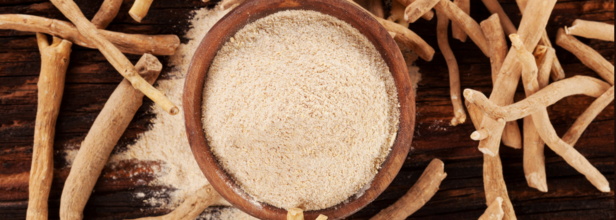- Health Conditions A-Z
- Health & Wellness
- Nutrition
- Fitness
- Health News
- Ayurveda
- Videos
- Medicine A-Z
- Parenting
- Web Stories

6 Health Benefits Of Ashwagandha And Side Effects
6 Health Benefits Of Ashwagandha And Side Effects
Ashwagandha is an herb that has gained immense popularity in the Western wellness circles with its promising health benefits. Ashwagandha originates from ancient Indian healing traditions. The herb has been used for thousands of years to enhance mental and physical well-being. Ashwagandha offers a whole approach to health, it counters mental concerns as it does physical. Starting with fighting stress and reducing mental degradation up to your muscular performance and fertility, the amount of uses is massive.
Although there is still research into the benefits of ashwagandha, this is one of the more popular natural remedies. It's always a good idea to consult a healthcare professional before adding any supplement, especially if you have other conditions or are on medication.
So, what makes ashwagandha such a standout in the world of natural medicine? Let's explore its origins, potential benefits, and practical uses.
What is Ashwagandha?
Botanically, the plant is known as Withania somnifera, often called "Indian ginseng" or "winter cherry." The Sanskrit name translates to "smell of the horse," probably describing its strong odor and belief that the herb would give the same strength as a horse.
Originally coming from the shores of India and Southeast Asia, ashwagandha is a small, small yellow-colored shrub. These have been used in combination roots, powders, extracts, supplements prepared from the leaves which fight stress to infertility health complaints.
Health Benefit of Ashwagandha
The tradition, however, is extremely big, and now a whole lot of research that aims towards modern applications in medicine started appearing.
1. Stress Reduction and Anxiety Management
Ashwagandha is classified as an adaptogen, meaning it helps the body manage stress. Studies indicate that taking 125–1,000 mg of ashwagandha extract daily can significantly lower cortisol levels, the hormone associated with stress. Participants in clinical trials reported reduced feelings of anxiety and stress, supporting its traditional use as a calming agent.
2. Improved Cognitive Function
The randomized, double-blind, placebo-controlled studies showed evidence that ashwagandha may be used to enhance brain function. It improves executive functioning, attention, reaction time, and performance on cognitive tasks. This may be valuable for the elderly and for those suffering from mild cognitive impairment.
3. Enhances Physical Performance
The benefits of ashwagandha do not stop at physical health. It is also used to enhance athletic performance. Research indicates that 330–1,250 mg daily can increase muscle strength and reduce muscle fatigue, improving recovery. It also prevents muscle soreness, so it is a great supplement for athletes.
4. Reproductive Health and Hormonal Balance
Ashwagandha has been proven to enhance male fertility. According to a review of studies, the herb taken for 90 days enhanced sperm concentration, semen volume, and sperm motility. It also increased testosterone levels and luteinizing hormones, which are important for reproductive health.
5. Arthritis Relief
Preliminary studies indicate that ashwagandha may help in alleviating symptoms of rheumatoid arthritis. In one study, patients reported reduced joint pain and stiffness after consuming 10 grams of ashwagandha powder daily for three weeks followed by additional Ayurvedic treatments.
6. Improved Sleep Quality
Ashwagandha may also assist in promoting sleep. Its sedative effects help normalize the different stages of sleep and make it one of the remedies that are advisable for those who sleep with insomnia or whose sleep cycles are disturbed.
How to Use Ashwagandha
There are varied forms of ashwagandha such as:
- Capsules and Tablets - best suited for daily intake.
- Powder - blends well when mixed with milk, smoothies, or sweet liquids to mask a bittersweet flavor.
- Tea: Provides a relaxing manner of consumption and its benefits.
- Topical Creams: It is usually applied as a local application, but it's not as common.
The root or the root-and-leaf extract is the most common part of the plant. These contain withanolides, active compounds, which are believed to possess therapeutic properties, for example, anti-inflammatory and promoting brain health.
Is Ashwagandha Safe?
For the majority, ashwagandha is safe for when taken at the recommended dosage for up to three months. However, large dosages trigger gastrointestinal problems like abdominal pain, diarrhea, or vomiting. In rare cases, liver problems might be caused, so people with prior liver disorders should be careful as well.
Some people should strictly avoid taking ashwagandha altogether. These include:
People who are pregnant: It may lead to miscarriage.
Those individuals who are breastfeeding: Insufficient data is available on its safety.
Those undergoing surgery: It may interact with anesthesia and slow the nervous system.
Individuals with thyroid disorders: Ashwagandha may increase thyroid hormone levels.
Side Effects and Precautions
While mostly safe, ashwagandha sometimes causes mild side effects, including constipation and gastrointestinal distress, especially if higher dosages are used. People starting their journey with ashwagandha should begin by taking low dosages under the advice of a doctor to be sure it suits their needs.
LiverTox: Clinical and Research Information on Drug-Induced Liver Injury. [Internet]. Ashwagandha. Bethesda, MD: National Institute of Diabetes and Digestive and Kidney Diseases; 2012.
American Botanical Council. Ashwagandha.

Credit: Canva
Is Climate Change Affecting The Rice In Your Kitchen?
As climate change intensifies, researchers have predicted that arsenic in rice could increase and trigger a major public health crisis. Rice is a staple in many countries. In Asia, particularly in Japan and Korea, it is an important component in all meals. A rise in the arsenic, therefore, could seriously exacerbate deadly diseases, including cancer.
What is Arsenic?
Arsenic is a naturally occurring metallic element, widely distributed in the Earth's crust and found in various forms, like inorganic and organic. Research shows that it is toxic and does lead to severe health issues like cancers of the bladder, lung and skin, as well as several cardiovascular and neurological diseases.
Why is arsenic content in rice increasing?
Researchers from Colombia University, stated that an increase in temperatures above 2 degrees Celsius combined with rise in carbondioxide in the atmosphere can alter the soil chemistry, favouring arsenic, which gets more easily absorbed in rice grain. Contaminated soil and irrigated water while growing rice are known to increase inorganic arsenic in rice.
What Did Researchers Say?
The study was conducted by researchers from Columbia University and published in The Lancet Planetary Health. The study explained that an increase in temperatures above 2 degrees Celsius and rising levels of carbon dioxide could be causing changes in soil chemistry, favouring arsenic, which gets more easily absorbed into a rice grain. Contaminated soil and irrigated water from that area, while growing rice are known to increase inorganic arsenic in rice.
"Our results suggest that this increase in arsenic levels could significantly elevate the incidence of heart disease, diabetes, and other non-cancer health effects," said author Lewis Ziska, associate professor of environmental health sciences, Columbia University, said. "We found that temperature and CO2 act synergistically to increase arsenic concentrations in rice, compounding dietary arsenic exposures for rice consumers and leading to projected cancer cases in the tens of millions among populations of Asian countries in 2050," according to the study.
Are there any mitigation strategies?
There are ways to mitigate arsenic exposure. This includes breeding plants to minimise arsenic uptake and improved soil management in rice paddies, along with health initiatives. THE US FDA also recommends replacing cereals from rice with those with whole grains. Published studies, including research by the FDA, show that cooking rice similar to how pasta is cooked can reduce 40 to 60 per cent of the inorganic arsenic content, depending on the type of rice. However, this method of cooking rice in excess water—using 6 to 10 parts water to 1 part rice and then draining the excess water—also results in lowering the nutritional value of enriched polished and parboiled rice

Credits: YouTube and Instagram
The Longevity Diet: Bryan Johnson Eats 3 Meals In 6 Hours—With Extra Virgin Olive Oil
Bryan Johnson, the 47-year-old tech entrepreneur who is known for his anti-ageing techniques and for his quest to reverse his biological age has finally ditched the medicine that has kept him young. He had recently been featured in Netflix documentary Don't Die: The Man Who Wants To Live Forever, where he has shown his various attempts on achieving more time on the planet, his quest for longevity.
To live 'forever' he had been consuming 13 milligrams of immunosuppressant rapamycin for the last five years. However, he has now given it up after he found out that the side effects outweighed the advantages.
As per the opinion article published in Impact Journals, titled Rapamycin for longevity, it can extend maximum life span nearly three-fold. It can also prolong life in normal mice as well as in yeast, worms, and flies, and prevents age-related conditions in rodents, dogs, nonhuman primates and humans. It has been FDA-approved for humans and has been used safely for decades. In 2006, it was suggested that rapamycin could be used immediately to slow down aging and all age-related diseases in humans. However, another study published in Oncotarget, titled About-face on the metabolic side effects of rapamycin, it can lead to metabolic defects, including hyperglycemia, hyperlipidemia, insulin resistance and increased incidence of new-onset type 2 diabetes.
Now without the medicines, what all does Johnson do to keep his quest for longevity going? He focuses on what he eats!
The Diet For Longevity
On a podcast with Jay Shetty on his show On Purpose, he revealed that he ensures his daily diet is roughly of 2,500 calories per day and his meals are all between 6 am and 11.30am. The NHS also recommends that an average man needs 2,500kcal a day.
His day starts with 54 supplements and an hour in the gym. He also revealed that he has never had cheat meals in his life ever. "Now the idea of eating a piece of pizza or a whole pizza or like a doughnut or something just makes me sick. Because if I'm going to do it, there'll be like five seconds of maybe enjoyment and then you've got like an entire day of misery."
What does he eat? He consumes "A lot of broccoli, cauliflower, lentils, hemp, pea protein, hemp protein, berries, nuts, seeds."
What Are The Three Meals In 6-Hours He Eats?
The Supper Veggie
This consists of broccoli, cauliflower, black lentils, ginger, and garlic.
The Nutty Pudding
This is made with macadamia nuts, walnuts, flax seeds, pomegranate juice, and berries, combined with pea and hemp protein.
A Mix Of All
The third meal can vary, but it usually includes a mix of all, vegetables, berries, nuts, and seeds.
ALSO READ: Bryan Johnson Launches New Religion 'Don't Die'- Here's How To Become A Member
The Extra Virgil Olive Oil On The Side
He also revealed that additionally, he also consumes a tablespoon of extra virgin olive oil with each meal and 6g of pure cocoa. "We’ve tried to construct a perfect diet, so every single calorie I consume has a specific objective," he says. This is a "stack superfoods across the board".
He is currently consuming 80 grams of protein, after he struggled at 120 grams of protein. His gut health could not take it.
Johnson also compared extra virgin olive oil to Ozempic, due to its potential health benefits and benefits in weight management and glucose control.
In one of the episodes of All The Diary Of A CEO podcast, he said, “What things can I do in my life that are easy and actionable, and have a high impact? Extra virgin olive oil is very close to number 1. It is better than Ozempic. It is.”
Johnson says that both Ozempic and extra virgin olive oil can stimulate the release of GLP-1, which is a hormone that regulates appetite and blood sugar levels. The extra virgin olive oil is a high-quality oil that is extracted from the first pressing of olive and is thus considered the purest and healthiest oils due to its rich nutritional profile.
“There is a study, where people lost 5.2 pounds consuming EVOO for nine weeks (in addition to what they are currently eating). I think the quantity for the study was 45 ml daily or something like that; it is between 30-60 ml daily. But there's things, for example, like it reduces by over 60 percent invasive breast cancer, it reduces your blood sugar levels by 60 percent post a meal and your oxidised LDL levels. The bad thing is that your body is causing damage by 80 percent post a meal. So, I have a tablespoon (of olive oil) with every single meal and it is like the super of superfoods," he said.

Credits: Canva
What Is RFK's Food Dye Plan?
Robert F Kennedy Jr has been a longtime critic of synthetic additives. He has, from time and again emphasized that Americans are consuming artificial chemicals without their knowledge or consent. "Four years from now, we are going to have most of these products off the market - or clearly labeled so you know what you are buying," he stated during a press briefing.
Now, a major announcement was made on Tuesday by the Trump administration on its plan to phase out petroleum-based artificial food dyes from the US food supply. The Trump administration and the Department of Health and Human Services (HHS), headed by Robert F Kennedy Jr., described this as a "significant milestone". The initiative is part of the broader health campaign which is branded "Make America Healthy Again".
The move is set to initiate a nationwide transition toward natural color alternatives in food production.
The National Standard
The HHS, in collaboration with the US Food and Drug Administration (FDA) said that they will establish a national standard to help the food industry move away from synthetic petrochemical dyes. This also is said to include a timeline, which will be set to replace these dyes with safer, plant-based or naturally derived alternatives.
The Dyes That Could Be Affected
The first major regulatory action under this plan involves revoking authorization of two dyes, namely Citrus Red No.2 and Orange B. The officials have also selected six more synthetic dyes to be eliminated by the end of 2026. These include FD&C Red No. 40, Yellow No. 5, Yellow No. 6, Blue No. 1, Blue No. 2, and Green No. 3.
The FDA is also planning to approve four new natural color additives shortly after a review of the additional alternatives.
FDA Commissioner Martin Makary said that for decades, American children have been "living in a toxic soup of synthetic chemicals." The administration's latest steps, he noted, are a strong move towards the elimination of petroleum-based food dyes.
Are Food Dyes Safe For Us?
As of now, the FDA defines food dyes or color additives as any substance that imparts color to food, drugs, cosmetics, or the human body. These dyes are commonly used to enhance visual appeal and to help consumers identify flavors.
While FDA guidelines state that color additives are generally safe when used correctly, there is growing concern. Some studies have linked artificial dyes to behavioral issues in children, including hyperactivity. Kennedy remarked that there are “shockingly few studies” on many of the ingredients in widespread use, calling for more thorough research.
To that end, the administration announced a partnership with the National Institutes of Health (NIH) to investigate the impact of food dyes and additives on children's development and health.
What Has Been The Response?
The plan, as of now, does not impose immediate legal restrictions. The government, however, is working closely with food manufacturers to implement the changes. Kennedy reported a positive response from industry leaders and said there is a general "understanding" of the need for reform, even if no formal agreements are in place.
Consumer and advocacy groups have praised the announcement. The Environmental Working Group (EWG) called the move “long overdue,” citing decades of evidence linking synthetic dyes to health issues. States like California and West Virginia have already passed laws restricting the use of artificial dyes in school meals and packaged foods.
However, not everyone is on board. The Consumer Brands Association, representing food and beverage companies, warned against removing what they consider safe, FDA-approved ingredients. While expressing appreciation for federal leadership, the group insisted that science and product safety must not be compromised.
© 2024 Bennett, Coleman & Company Limited

